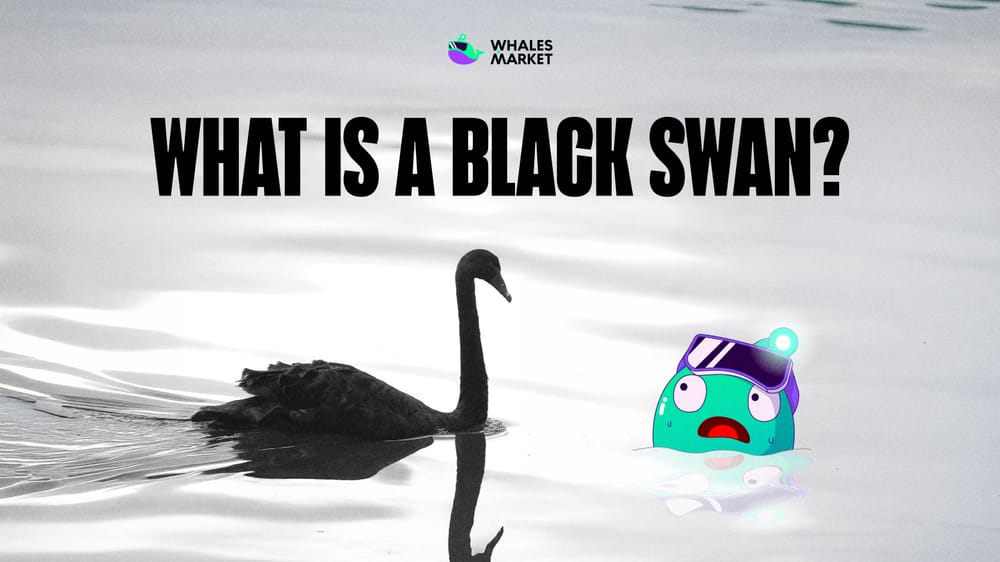In today’s volatile world, Black Swan events are rare, unpredictable occurrences that disrupt markets, economies, and everyday life. These sudden shocks remind us how fragile our systems are and why understanding them is essential for managing future risks.
What is a Black Swan?
Black Swan is referring to rare, unexpected events that no one can predict, but which cause massive consequences and completely change the landscape. This concept was introduced by Nassim Nicholas Taleb in his book "The Black Swan" in 2007.
To be considered a Black Swan, an event must:
- Lie outside all normal predictions.
- Have an extremely large impact, and afterward, people try to explain it as if it could have been foreseen.
Think of it simply: Many people believe all swans are white because you've never seen anything else, then suddenly a black swan appears - that's a huge surprise. In finance, Black Swans are often economic crises, pandemics, or major collapses that send markets plummeting before anyone can react.

The Impact of a Black Swan on the Financial Market
A Black Swan can upend the entire financial system in an instant, creating widespread and long-lasting damage. In traditional markets, it often causes economic recessions, erodes investor confidence, and triggers a domino effect that sharply reduces the prices of stocks, bonds, and commodities.
Banks may face liquidity shortages, leading to mass withdrawals, economic stagnation with high unemployment, and disrupted supply chains.
Governments must intervene with massive bailout packages, but recovery can take many years.
In crypto, Black Swan events hit even harder. The market’s high volatility, leverage, and interconnected systems mean that a single shock can trigger a chain reaction.
For example, from sudden Bitcoin crashes and stablecoin depegs to billions in liquidations across DeFi and CEXs.
A Black Swan causes sudden price drops (like Bitcoin losing thousands of USD in a day), stablecoins losing their peg, liquidations of billions of USD in futures and margin orders, and exchange network congestion.
Panic leads to mass sell-offs, affecting DeFi protocols (liquidity pools on Curve, Uniswap) and CeFi. Overall, it reduces market capitalization, shakes confidence, delays widespread crypto adoption, and may lead to stricter regulations from governments.
Some Notable Black Swans in the Traditional Financial Market
The traditional financial market has experienced many Black Swans that shocked the world. Below are notable examples, with details on causes, consequences, and lessons, updated as of October 14, 2025:
- Black Monday (1987): On October 19th, 1987, the U.S. stock market suddenly collapsed, with the Dow Jones index losing 22.6% in just one day - the largest drop in history. The main causes were automated trading (program trading) combined with panic selling, plus high interest rates and economic tensions. Consequences: Billions of USD lost, spreading to global markets, but the market recovered quickly thanks to Fed intervention.
- Dotcom Bubble (2000-2002): From the late 1990s, excessive faith in internet technology inflated the values of dotcom stocks (like Amazon, Google). By 2000, the bubble burst when interest rates rose and actual profits fell short of expectations. Consequences: Numerous companies went bankrupt, investors lost trillions of USD, the Nasdaq dropped 78%, leading to a U.S. economic recession and a slowdown in tech investments.
- Global Financial Crisis (2008): Originating from the U.S. real estate market with subprime mortgages, leading to Lehman Brothers' bankruptcy on September 15th, 2008. The domino effect paralyzed the banking system and froze credit. Consequences: Global recession, soaring unemployment (the U.S. lost 8.7M jobs), stock markets dropped 50%, governments spent $700B on bailouts.
- COVID-19 Pandemic (2020): The disease spread widely from early 2020, causing global lockdowns, halting production and travel. The U.S. stock market plummeted (Dow Jones lost nearly 25% in March 2020), supply chains broke down. Consequences: Global economic recession, high unemployment (the U.S. reached 14.7%), but it also accelerated digital transformation. Governments pumped trillions of USD in stimulus.
As of October 14, 2025, there hasn't been a major new Black Swan in traditional markets, but potential risks like geopolitical conflicts, high inflation, or AI crises are being closely monitored. Experts warn of "double black swans" like high interest rates and sudden recessions.

Some Notable Black Swans in the Crypto Market
The Crypto market is easily affected by Black Swans due to its high volatility and reliance on sentiment. Below are notable examples, with details on causes, consequences, and updates as of October 14th, 2025:
- Terra-LUNA/UST Collapse (May 2022): Stablecoin UST lost its peg due to algorithmic mechanism failure, combined with massive sell-offs. LUNA's price dropped from $80 to near zero in a few days. Consequences: The Terra ecosystem collapse, global crypto market cap dropped over $400B, spreading to other DeFi like Anchor Protocol.
- FTX Bankruptcy (November 2022): The world's second-largest exchange collapsed due to misuse of customer funds and FTT token devaluation. Consequences: Sharp market cap drop, Solana lost 50% value, numerous investment funds suffered losses of billions of USD, leading to tighter regulations.
- Silicon Valley Bank Collapse (March 2023): SVB went bankrupt due to rising interest rates devaluing bonds, leading to the depegging of stablecoin USDC. Consequences: Billions of USD frozen, massive liquidations in DeFi (Aave, Uniswap), spreading to exchanges like Binance.
- Flash Crash in August 2024: Rumors of Jump fund dumping ETH led to Bitcoin dropping 12.8% to $49K. Consequences: $1B in long orders liquidated, altcoins plummeted.
- Largest Flash Crash in History (October 10-11, 2025): The event dubbed the "biggest black swan in crypto," stemming from President Trump's announcement of 100% tariffs on Chinese goods, causing global sell-offs. Combined with deleveraging, flash crash on BitMEX, and possibly targeted attacks on Binance. Consequences: Record liquidations over $19B.
These events show that crypto is vulnerable to internal factors (fraud) and external ones (global economy).

How to Prepare for a Black Swan?
Black Swans can't be fully predicted, but you can prepare to reduce damages. Looking back at past crises, here are the things you should do to minimize damage:
- Risk Planning: This is extremely important. The market is always right - remember that. Instead of making one-sided predictions, create various scenarios. If prices rise, do we have inventory? If they fall, do we have cash to buy?
- Risk Management: Use stop-loss, avoid excessive margin, invest only spare money. Monitor news for early signs.
- For Crypto: Choose reputable exchanges, use cold wallets, follow regulations. In 2025, DeFi insurance and reserve funds are helping reduce risks.
Q1. What is a Black Swan event?
A Black Swan event is a rare and unpredictable occurrence that causes massive impact on markets, economies, or something no one could foresee in advance.
Q2. Why are Black Swan events important in finance?
They expose hidden weaknesses in financial systems, causing market crashes, liquidity shortages, and global recessions, while teaching valuable lessons about risk management.
Q3. Can a Black Swan be predicted?
No. By definition, a Black Swan lies outside normal expectations. However, understanding past crises helps investors prepare for extreme uncertainty.
Q4. What are some famous Black Swan events?
Notable examples include the 1987 Black Monday crash, the 2008 Global Financial Crisis, the 2020 COVID-19 pandemic, and the 2022 FTX collapse in crypto.
Q5. How do Black Swans affect the crypto market?
Due to high volatility and leverage, crypto markets suffer sharper drops, mass liquidations, and stablecoin depegs making recovery more difficult.
Q6. How can investors protect themselves from Black Swan risks?
Diversify assets, avoid excessive leverage, set stop-loss orders, and hold cash reserves. In crypto, use reputable exchanges and secure cold wallets.
Q7. Why should I consider trading in the pre-market during a Black Swan event?
Pre-market trading lets investors act before tokens are listed and hit by market panic. Since these tokens haven’t gone through TGE, prices are steadier, allowing smarter analysis and early profit opportunities. Whale Market is the best platform for that.

